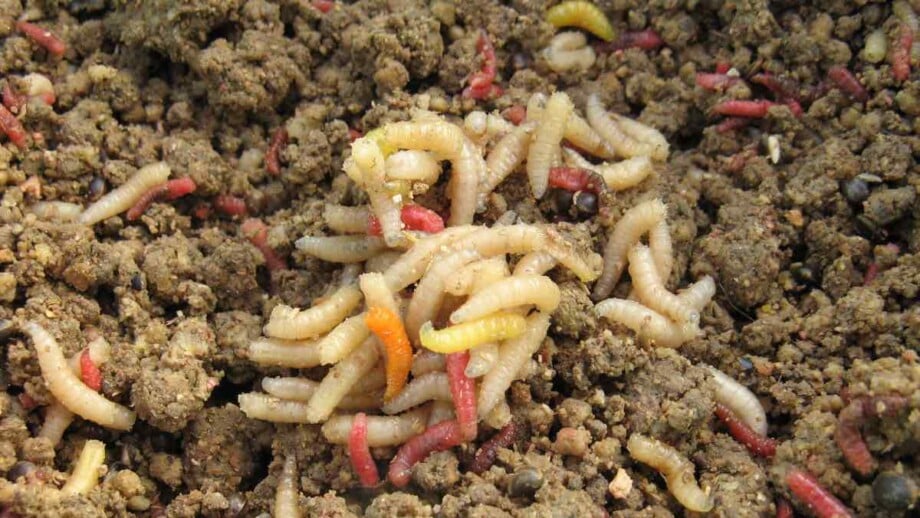Did you just find some maggots in your home or yard? Maggots can appear in different areas around your house, including the backyard, and sometimes even on pets.
There are many different types of maggots, and the term generally refers to the larvae of dipteran flies such as the common housefly and bluebottles. Outdoors, there are other types of maggots such as the root maggot or seedcorn maggots.
Each type requires slightly different treatment methods to get rid of these pesky invaders once and for all. If you’re dealing with a maggot infestation, this article is perfect for you.
Not only will it help you understand what exactly they are and the common types, but also how to get rid of them in your home and outdoors. As a bonus, we share all the ways you can prevent future infestations.
What are Maggots?
The term ‘maggot’ refers to the larvae of dipteran flies such as common housefly, bluebottles, and blowflies. These flies are distinguished by their small bodies and antennae. Because of this, maggots of all species have similar appearances.
They feed on the decaying organic matter and the dead tissues of living organisms. From the beginning of a maggot’s life cycle to an infestation of hundreds of maggots takes only 8 to 20 hours.
There are different types of maggots, depending on what kind of insect they come from and the area they are infesting.
How to Identify Maggots
Maggots resemble tiny cream-colored worms, and the largest can grow to be 3/4th of an inch long. Maggots don’t have any legs, but they do have two tiny hooks that they use to eat with.
Are Maggots Dangerous?
Even though flies are more well-known for spreading disease and being annoying, maggots are not dangerous and can even save lives.
Maggot therapy is a common medical practise in which specific species of maggots are farmed for hospital use. They eat dead tissue and rotting flesh to get rid of bacteria in wounds that have become infected. In some cultures, maggots are considered a delicacy.
Common trash maggots, on the other hand, are probably contaminated with bacteria and could lead to bacterial poisoning if consumed.
So if you ever see maggots, it’s time to deal with them. And this is especially the case if found outdoors on crops that they will most likely be feeding on and damaging.
Common Types of Maggots
Housefly
People often find maggots in their homes. These are the house fly maggots and can be really annoying pests. Populations of housefly maggots can pose a threat to human health because they are known to spread a number of pathogens and diseases.
The eggs of a house fly resemble rice grains. Within a day, the eggs hatch, and the larvae of house flies appear. Their sole purpose is to consume food and store energy in preparation for pupation. Larvae feed for about five days before seeking out dry, dark areas for pupal development.

Apple
One of the worst fruit pests in the United States is the apple maggot. Adult apple maggots emerge from the ground in the summer.
Female flies have four white bands on their abdomen, whereas males have four black bands. Both possess transparent wings with black bands.
After eating the honeydew on the leaves, the females start to make holes in apple skins and lay an average of 300 eggs under the skin of the fruit in 30 days.
In 2 to 10 days, the eggs hatch into maggots or larvae, and eat the fruit for about 30 days, tunnelling through it and making it rot. After this, the larvae fall to the ground, burrow, and transform into the pupal stage.
Most apple maggot pupae are less than 2 inches below the surface of the soil. They spend the winter in the soil and come out as flies in the summer.
The damage caused by apple maggots results in stunted fruit growth and misshapen, dimpled fruit. Insecticides can be used to get rid of maggots before flies start to lay their eggs.

Root
The root maggot is a common pest of onions and carrots. The adults of root maggots resemble small houseflies, and they lay their eggs in soil crevices or on the stems of plants growing near the ground.
These legless maggots range in colour from white to a pale yellow, and they cause plants to turn yellow after feeding on their roots for about four weeks. Maggot tunnels can be seen in the roots.
The best way to control root maggots is to rotate crops and use natural ways to get rid of them, like ground beetles and tiny wasps that eat maggots. In severe infestations, soil insecticides can be used.

Seedcorn
Seedcorn maggots are the larvae of small flies that feed on the seeds and seedlings of corn, beans, peas, and other legumes.
The adult flies lay their eggs in the soil near the seeds or seedlings. The larvae hatch from these eggs and feed on the seed or seedling for about 2 weeks before pupating in the soil.
Seedcorn maggot damage is characterized by wilting and yellowing of the seedlings, stunted growth, and reduced yields. Control measures include crop rotation, use of resistant varieties, and insecticides.
How to Get Rid of Maggots Indoors
If you’ve found maggots inside in your home, the following steps can help you get rid of them for good:
1. Sanitize the Area
If you have seen maggots, you have probably found the reason why they are there. Maggot infestations are typically caused by rotting food and filth, so you must locate the source of the filth and dispose of it, followed by a thorough sanitation.
The kitchen is usually the primary focus, as this is where food is most likely to spoil and garbage can accumulate, attracting flies and maggots.
You should wipe down the surfaces of your tables and counters, mop the floors, get rid of any sources of moisture, toss out any food scraps, and take out the trash. When it comes to getting rid of maggots all other pests in the kitchen, this is the most crucial step you can take.
If you see maggots in your garage or basement, clean the area well by sweeping and mopping. Remove any rotting trash and put it right away in a trash can with a tight-fitting lid that is kept outside the house.
If the maggot problem is mostly outside, clean up areas where you’ve seen flies, such as around spoiled dog food, dropped food, pet fecal matter, and other filth.
2. Try Salt
Maggots require water to grow and survive, and salt naturally dehydrates things.
Use a lot of salt to kill the pests by dehydrating them. Once the maggots have died, sweep them into a plastic bag and discard them.
Be sure to thoroughly clean the affected area!
3. Pour boiling Water
If you have a problem with maggots in your trash can or dumpster, boil some water and pour it into the can or down the garbage disposal if the maggots have made their way there.
If you want to ensure that all the maggots are dead, you may need to use this method more than once.
4. Sprinkle Diatomaceous Earth
Diatomaceous earth is a natural powder that can be used for many different things around the house. This is an effective strategy for eliminating maggots from carpets and other similar fibrous materials.
Spread enough of it on the maggots to cover them completely. The powder adheres to their bodies and causes their exoskeleton to become dehydrated, which ultimately kills them
Put the dead maggots in a plastic bag and throw them away. Then clean the area very well.
5. Use White Vinegar
Maggots can’t live in vinegar because of how acidic it is.
Create a solution by adding one part vinegar to three parts water, and then pour the mixture directly over the maggots.
Let the mixture sit for about an hour before getting rid of the maggots and cleaning the area.

How to Get Rid of Maggots Outdoors
If you have maggots outdoors infesting your crops, here are a few things you can do to get rid of them:
1. Sanitize Your Yard
After harvesting the crops in spring, remove or destroy any leftover debris and culls from the fields. It is important to get rid of culls before the new crop emerges for the season.
2. Rotate Crops
Rotate crops to keep maggot populations under control. Maggots remain in the soil after the season, so it is critical to replant the area with something that will not encourage them and flies to reproduce.
Rotate feeder plants such as turnips, broccoli, onions, leeks, cauliflower, cabbage, and radishes as far as possible from their previous location.
It is preferable to relocate them to a completely separate section of the garden, but this isn’t always possible with a backyard garden. Plants like beans, peas, tomatoes, peppers, eggplant, melons, and squash are safer to grow in areas with pests.
Crop rotation is a best practise for gardens in general because it helps discourage a wide variety of plant-specific pests that can affect many different kinds of crops.
It’s possible that if you move your crops away from the area where the maggots are thriving, you’ll see a significant improvement in the yield of those other crops as well.
3. Plant More Tolerant Varieties
When possible, plant varieties that are resistant to maggots to avoid the problem as much as possible. Unfortunately, we don’t have resistant varieties to crops such as onions.
4. Use Sticky Traps
Yellow sticky cards can be used as a monitoring tool to assess the level of pest infestation around fields. They can also be used as a control measure by reducing the amount of adult populations before egg laying occurs, which can help prevent further infestation.
5. Use Row Covers
If row covers are used over transplants at the time of planting, egg laying will be greatly reduced. Put a floating row cover over the seed beds right after you plant them to keep pests out.
Ensure that the cover goes at least 6 inches beyond the seed rows on all sides. When the plants are large enough to withstand damage, the covers can be removed.

How to Prevent Maggots
Now that you know how to get rid of maggots, it’s important to also figure out how to prevent them in the first place.
A home kitchen, a garage, a yard, and even a restaurant will all attract maggots if basic sanitation standards aren’t followed. The next steps should be taken on a regular basis to avoid further maggot infestations:
- Clean all of your tabletops and bathroom counters.
- Mop every surface and floor with an antibacterial cleaner.
- All food should be stored in airtight containers.
- Keep the dish covered when you leave pet food out so that flies don’t get in, and be sure to quickly throw away any food that has gone bad.
- If you keep compost in your yard, keep it covered or sealed to keep flies out.
- Seal your trash bags and cans properly so that nothing can breed or enter.
- To reduce the number of flying insects, caulk any cracks and crevices they might use to enter your home.
Download our infographic:

Other Pest Control Articles from Planet Natural:











